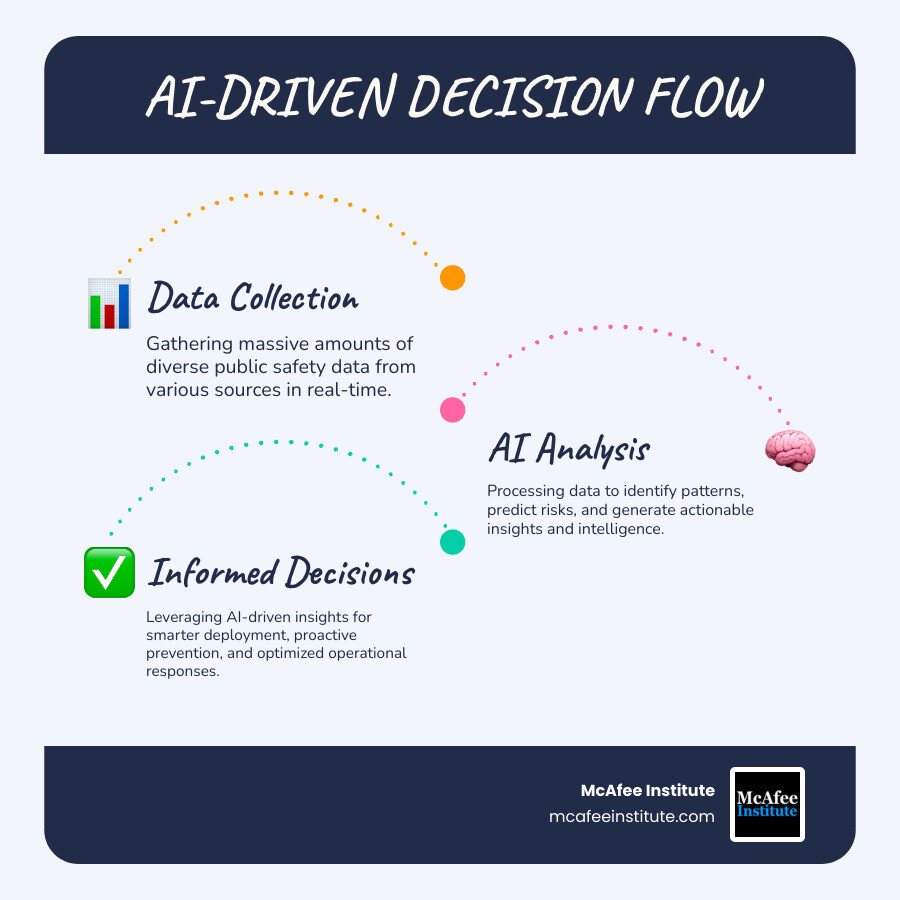Why AI and Data-Driven Decision-Making Matter for Public Safety Leaders
AI, paired with data-driven decision-making, is changing how agencies protect communities. As departments face tighter budgets and rising expectations, AI offers a way to work smarter, not harder. It processes massive amounts of data in real time, giving leaders the intelligence to reduce crime, save lives, and allocate resources more effectively.
Key Benefits & Applications:
- Crime Reduction: Predictive analytics can help cut crime by 30-40%.
- Faster Response: Improve emergency response times by 20-35%.
- Resource Optimization: Use real-time data for smarter personnel and equipment deployment.
- Improved Accuracy: Predict critical incidents with up to 86% accuracy.
However, technology alone doesn't solve problems--leaders do. Successful agencies build strategies around data quality, ethics, and accountability. They train their teams, engage their communities, and keep humans at the center of every decision. This isn't about replacing officers with algorithms; it's about providing a force multiplier that handles data analysis, so professionals can focus on protecting people and building trust.
This guide offers a roadmap for police chiefs, emergency managers, and operations leaders to implement AI responsibly. Built on real-world experience, it covers what works, what to avoid, and how to lead in the AI era.

The Current Landscape: How AI is Enhancing Public Safety Operations
AI is already at work in police departments, fire stations, and emergency call centers, with remarkable results. Cities using AI-powered tools are seeing crime drop by 30-40% and emergency response times improve by 20-35%. These outcomes represent lives saved and communities made safer.
AI's power lies in its ability to process massive amounts of data in seconds, identifying patterns a human analyst might miss. This enables a shift from reactive to proactive public safety, which is central to data-informed leadership in this field. Agencies can now anticipate and prevent problems, tapping into the vast potential of AI for Good in this sector.
Improving Crime Analysis and Resource Allocation
AI is changing crime analysis and resource allocation. Instead of relying on intuition and basic statistics, agencies can use AI to work proactively.
- Predictive policing models analyze vast datasets--including historical crime records, weather patterns, and local events--to forecast where and when crimes are most likely to occur.
- Geospatial location technology visualizes crime hotspots with high accuracy, enabling optimized officer deployment. This leads to fewer wasted patrol hours and more strategic coverage.
The primary benefit is proactive crime prevention. By anticipating crime upticks, departments can deploy resources to prevent incidents before they happen. For more on this, see How AI is Transforming the Future of Investigations.
Enhancing Emergency Response and Crisis Management
In emergencies, seconds matter. AI is proving to be a lifesaver in crisis management.
- AI-powered triage systems prioritize emergency calls more effectively than conventional methods, ensuring critical cases get help faster.
- Optimized routing for emergency vehicles analyzes real-time traffic and road closures to find the fastest route to an incident.
- Wildfire and flood prediction systems use AI to analyze weather and satellite data, providing early warnings. For example, one AI tool predicts fire flashovers with 86% accuracy.
- Drones integrated with AI, such as in Drone as First Responder (DFR) programs, provide critical situational awareness for command centers.

Ensuring Safety at Public Events
AI helps manage large crowds at events like concerts and protests. Crowd density analysis monitors and predicts crowd movement, while real-time bottleneck identification spots dangerous choke points before they form. This gives security teams time to intervene. For instance, Greater Manchester Police used N-AI's platform to process live drone footage during a football match, allowing them to monitor crowd formations and prevent safety issues. This is the promise of AI-driven, data-informed public safety: giving humans the tools to make better, faster decisions.
Building the Foundation for AI and data-driven decision-making for public safety leaders
Implementing AI successfully requires more than just buying software. A solid foundation is essential for effective use in public safety. This means having modern IT infrastructure, a clear data strategy, and high-quality data.
Your agency needs an IT infrastructure capable of large-scale data processing, including secure cloud storage and high-speed networks. Modernizing legacy systems is no longer optional. A comprehensive data strategy is also crucial, with clear policies on data collection, storage, access, and security. Implementing a zero trust architecture, where no user or device is automatically trusted, is a modern security baseline.
Integrating Qualitative and Quantitative Data
Effective AI relies on a mix of data types. Quantitative data (crime rates, response times) tells you what is happening, while qualitative data (officer narratives, community feedback) explains why. Integrating both provides a holistic understanding of community issues. For example, numbers may show a spike in burglaries, but officer reports might reveal it's due to a new gang's activity. This combined approach creates more accurate AI models that account for real-world context, a fundamental aspect of intelligence-led policing. To learn more about gathering diverse data, see this Understanding OSINT: A Comprehensive Guide.
Ensuring Data Quality for Reliable AI in Public Safety
AI is only as good as the data it's fed. "Garbage in, garbage out" is the rule, and flawed data leads to flawed insights and dangerous decisions. Key practices include:
- Data Cleanliness: Remove duplicates, correct errors, and standardize formats across all systems.
- Data Validation: Regularly check data for accuracy and completeness, cross-referencing sources and flagging anomalies.
- Addressing Model Drift: Real-world conditions change, and AI models can become less accurate over time. This "model drift" requires regular monitoring and retraining with fresh, validated data to ensure the AI's predictions remain reliable.

Building this foundation is the difference between an AI system that transforms your agency and one that fails. Prioritize infrastructure, data integration, and quality standards for success with AI and data-driven decision-making for public safety leaders.
A Leader's Guide to Navigating Challenges and Ensuring Ethical AI Implementation
AI-powered, data-driven approaches come with great potential and serious responsibilities. Rushing into AI without addressing the ethical dimensions can perpetuate bias, violate privacy, and erode community trust. Leaders must steer these challenges to harness AI's power while protecting civil liberties.
Key challenges include:
- Algorithmic Bias: AI learns from historical data. If that data reflects past inequities, such as over-policing certain neighborhoods, the AI may amplify those biases.
- Privacy Concerns: AI requires vast amounts of data, raising questions about collection, storage, and use that respect individual rights.
- Transparency: Many AI systems are "black boxes," making it difficult to understand their reasoning. This lack of transparency hinders accountability.
- Public Engagement: Communities must be informed about how AI is used. Without dialogue, even well-intentioned initiatives can face backlash. The federal government's Executive Order on the Safe, Secure, and Trustworthy Development and Use of Artificial Intelligence underscores the need for responsible implementation.
Mitigating Bias and Ensuring Fairness
Ethical AI requires a commitment to fairness. The root of most AI bias is biased training data. To combat this, leaders should:
- Conduct regular audits to test AI systems for biased performance across different demographic groups.
- Build diverse development teams to bring varied perspectives that can identify potential blind spots.
- Adopt ethical frameworks, such as those developed by Northwestern University's CASMI. These guides, detailed in Ethical Framework Aims to Reduce Bias in Data-Driven Policing, help ensure AI is used for community benefit.
The Role of Human Oversight
AI is a tool, not a decision-maker. As Alphabet CEO Sundar Pichai noted, AI should be seen as an "assistant." It handles data analysis, but it lacks the judgment, empathy, and accountability of a trained professional.
This is why human-in-the-loop approaches are non-negotiable. An AI may suggest a course of action, but a human must review the recommendation, apply wisdom and context, and make the final call. Final decision authority must always rest with people.
To prevent overreliance on technology (automation bias), teams must be trained to vet AI outputs critically. Officers and analysts should question recommendations and consider factors the AI might miss. The goal is to create a culture where technology supports--but never replaces--human judgment and ethical reasoning.

AI provides powerful capabilities, but humans must decide how to use them responsibly.
Practical Applications for Modern Policing
AI-enabled, data-driven methods are already changing how modern policing works. Here are some practical applications:
- Real-Time Policing: AI-based geospatial technology assesses crime hotspots as they develop, allowing officers to respond to emerging patterns rather than old data. Drones and other tools provide improved situational awareness.
- Identity Recognition: AI improves the ability to identify suspects and find missing persons through facial recognition and biometric systems, amplifying human expertise.
- Crime Scene Assessment: AI can improve grainy footage, create 3D scene reconstructions, and analyze forensic evidence with greater precision.
- Administrative Task Automation: Tools that automate report writing and evidence transcription can reduce paperwork by up to 70-75%, freeing officers for community engagement.
- Fraud and Trafficking Detection: AI algorithms can analyze vast datasets to identify patterns indicative of financial fraud or human trafficking that are nearly impossible for humans to spot.
For more investigative techniques, explore these 5 Incredible OSINT Techniques to Supercharge Your Investigations in 2025.
Improving Officer Accountability and Performance
AI offers a data-driven way to support officer performance and accountability. By analyzing officer activity logs, AI can objectively identify trends in response times, case resolutions, and patrol activities. This allows for fair performance evaluations based on data, not anecdotes.
Crucially, AI can be used for use-of-force incident flagging, identifying patterns that may signal a need for early intervention, training, or support. It can also help track policy adherence and pinpoint specific training needs, from de-escalation to community engagement. The goal is not surveillance but support--using data to help every officer perform at their best.
Building Community Trust and Transparency
While technology alone doesn't build trust, transparent use of these tools can strengthen police-community relationships. Key strategies include:
- Disclosing AI Tool Usage: Be upfront with the community about what technologies are used and why.
- Forming Public Advisory Boards: Involve community stakeholders in shaping AI policies to ensure they align with community values.
- Sharing Anonymized Data: Demonstrate AI's value by sharing insights on crime trends or improved response times.
- Analyzing Community Feedback: Use AI to efficiently analyze feedback from surveys and public forums to better respond to community concerns.
Trust is built on honesty and results. Used transparently, AI can support both.
Frequently Asked Questions about AI in Public Safety
What are the essential first steps for a public safety agency to adopt AI?
Successful adoption starts with a strategic, phased approach. Don't try to overhaul your entire operation at once. Follow these essential steps:
- Start with a specific problem: Identify a clear, manageable challenge that AI can solve, such as reducing response times or improving resource allocation.
- Assemble a diverse working group: Include agency leaders, AI experts, legal counsel, and community representatives to guide the project.
- Assess your data readiness: Ensure you have clean, organized, and sufficient data to train the AI model effectively.
- Develop a pilot project: Test the AI solution in a controlled environment to work out issues and demonstrate value before a full-scale rollout.
- Prioritize transparency: Communicate openly with your staff and the community about the AI's purpose, capabilities, and limitations from day one.
How can smaller agencies afford to implement AI technology?
Smaller agencies can access AI without a massive budget. Consider these options:
- Federal and State Grants: Look for funding programs from the Department of Justice, Department of Homeland Security, and other agencies.
- State-Wide Licensing: Many states negotiate collective agreements with vendors, offering AI tools at a reduced cost.
- Cloud-Based Solutions: "Pay-as-you-go" software-as-a-service (SaaS) platforms lower the barrier to entry by minimizing upfront infrastructure costs.
- Academic Partnerships: Collaborate with universities on research projects to gain access to expertise and resources, often through joint grant funding.
Will AI replace public safety professionals?
No. AI will not replace public safety professionals. It is a tool that augments human expertise, not a replacement for it. As seen in fields like medicine, AI handles data-heavy analysis, freeing up professionals for tasks that require human skills. See the Wired article "Doctors, Get Ready for Your AI Assistants" for a parallel.
In public safety, AI excels at processing data at scale--analyzing crime patterns or optimizing routes. However, it lacks the intuition, empathy, and ethical judgment needed for community engagement and complex decision-making. AI frees up officers to focus on this critical human work, making their roles more impactful and rewarding.
Conclusion
AI and data-driven decision-making in public safety is no longer a future concept--it's a present-day reality. Leaders who adopt it thoughtfully and ethically will shape the future of public safety. As we've seen, AI offers tangible benefits, from reducing crime and improving response times to enhancing officer accountability. These are real outcomes that save lives.
However, success requires a solid foundation of IT infrastructure, clean data, and a commitment to ethical implementation. Leaders must mitigate bias, protect privacy, and ensure human oversight remains central. AI is a powerful tool, but the final decision must always rest with a human professional.
Your role as a leader is to champion responsible AI adoption. This means starting with pilot projects, engaging the community, and training your people to use AI as a partner. The future of public safety lies in a partnership between human and machine intelligence, where AI handles the data analysis so your team can focus on protecting people and building trust.
At McAfee Institute, we prepare public safety professionals for these challenges. Our government-recognized and employer-trusted certifications in intelligence, investigations, and law enforcement provide the skills to lead in the AI era. With lifetime access, live instructor support, and free updates for life, we are committed to your long-term success.
Ready to lead your agency into the future? Equip yourself with the knowledge to implement AI responsibly. We invite you to explore our programs and Become a Certified Executive Leader.











Share:
Cracking the Code: FBI Analyst Career Requirements
Your Intel Edge: Finding the Right Accredited Certifications